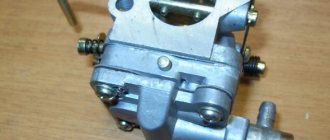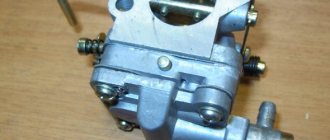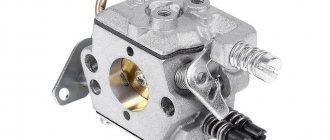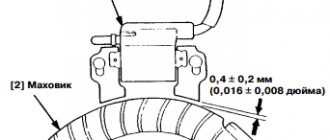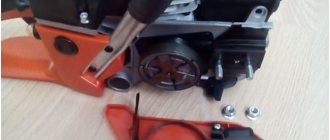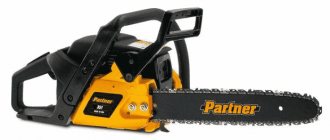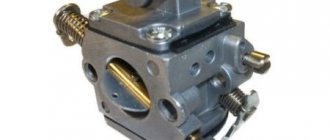One of the first Russian models of chainsaws that had a modern appearance and the ability to use the tool regardless of location in space was the Taiga 214 saw.
In this article we will look at its purpose, technical characteristics, adjustment capabilities and methods for eliminating basic faults.
Taiga 214 chainsaw device
The design features make it possible to cut any wood, including wet and freshly cut wood.
The saw model is equipped with a single-cylinder engine with a gearless drive. It is equipped with a muffler and auxiliary systems for power supply, cooling and lubrication of the sawing apparatus. For comfortable use, it has a balancing mechanism.
The cooling system is implemented using a fan and is of the air type. The saw chain is lubricated automatically under pressure without operator intervention.
Saw Taiga 214 without tire
Technical characteristics of the Taiga 214 chainsaw
The weight of the device excluding fuel and lubricants is 8.8 kg. At the same time, the fuel tank capacity is designed for 0.8 liters, and the volume of the lubricant reservoir is 0.3 liters. Overall dimensions of the chainsaw – 857x280x272 mm. The sawing apparatus consists of a 38 cm bar with a driven sprocket, and is complemented by a chain with a pitch of 9.3 mm.
Productivity is about 65 cm3/s, provided that workpieces with a diameter of up to 30 cm are cut. At the same time, fuel consumption is 440 g/hp/h. This is ensured by the use of a 3.5-horsepower engine. A gasoline-oil mixture in a ratio of 20:1 is used as fuel. For these purposes, gasoline grades A-72 or 76 and oil M-8A or AC-9.5 are used.
Noise pollution is within the norms and is limited to 106 dB.
Related Posts
Chainsaw Taiga 245
Taiga 245 is a chainsaw from a Russian manufacturer, produced at the Degtyarev plant, abbreviated as ZID. The high power of the motor allows it to be used both for work in the forest and for domestic needs. Today, the Taiga chainsaw is obsolete, but continues to enjoy popularity among the country's population. The saw rarely breaks, so let’s look at the main possible breakdowns and how to remove them with your own hands.
IMPORTANT. An experienced electrician leaked to the network the secret of how to pay half for electricity, a legal way. Read more
Application
Despite its power, the Taiga 245 chainsaw was not widely used by woodcutters (of which there are plenty of reviews about the saw) due to its low fault tolerance. Still, when working in the forest, you need a more reliable tool: Stihl, Makita, Husqvarna. Carburetor adjustment. The Taiga 245 chainsaw is different from a modern chainsaw. The saw found its main use in everyday life. It is perfect for all household purposes:
- cut a slab;
- cut down a small tree;
- saw old boards;
- trim branches;
- buck the whips.
Device
Taiga 245 is a modern chainsaw, made in a plastic case made of impact-resistant material. A photo of this chainsaw can be seen below Taiga 245 chainsaw from the carburetor and. Is not afraid of falls or impacts of medium strength, because... Most of the parts are made of metal. It should be noted that it weighs 8.95 kg, not including fuel. Such saws weigh significantly less.
Saw dimensions: 900 x 280 x 300. Supplied complete with a saw set based on a 40 cm bar and a chain with a pitch of 9.3 mm.
The Taiga chainsaw is based on a 2-stroke internal combustion engine with a power of 2.6 kW, which is achieved when the crankshaft rotates at 7000 rpm. The working volume is 75 cubic cm. The piston group cylinder is not hardened, this reduces the service life of the chain saw. Taiga 245 is a chainsaw with additional carburetor adjustments. This aspect is important for huge volumes of work, where the saw operates under load for a long time, virtually without stopping. In domestic use, it is not critical whether the piston is hardened or not. The piston size is 50 mm in diameter. The manufacturer advises using the chainsaw for less than 40 minutes; after this time, the tool should rest.
The chainsaw is not hazardous to the environment provided it is used with specially designed oils.
Taiga 245 uses universal motor oil for both the chain and the motor. It is diluted in a ratio of 1 to 20. Yes, yes, specifically 1/20 - this is a distinctive feature of the Taiga 245 saw. The brand of gasoline is AI-92. As noted above, the same oil is used to lubricate the chain as is used in the engine. In summer, the oil should be diluted with gasoline in a ratio of 1/4. According to reviews from many saw owners, used oil (waste oil), for example from a car engine, can be used to lubricate the chain.
Carburetor
The carburetor of the Taiga 245 chainsaw deserves special attention, because... most of the defects occur specifically in it. The carburetor of the Taiga 245 chainsaw may require additional carburetor adjustment. Taiga 245 is equipped with a floatless membrane-type carburetor KMP-100US, with an integrated pump. The pump supplies fuel from the tank to the carburetor.
Reviews of the Taiga 214 chainsaw
David The old saw was inherited from his parents. They bought it a long time ago. Starting it is difficult, almost impossible. Therefore, if it starts, it is better not to turn it off until the gas runs out.
Vladimir I literally have spare parts left from the saw. In an attempt to fix it, I dismantled it to the ground. As a result, it has been lying around in the garage for three years.
Tigran Compared to modern saws, this model is unreasonably heavy. It can only be used if there are no quality alternatives.
One of the first Russian models of chainsaws that had a modern appearance and the ability to use the tool regardless of location in space was the Taiga 214 saw.
In this article we will look at its purpose, technical characteristics, adjustment capabilities and methods for eliminating basic faults.
Frequent malfunctions
One of the first Russian models of chainsaws that had a modern appearance and the ability to use the tool regardless of location in space was the Taiga 214 saw.
Let's look at the main malfunctions of Taiga chainsaws, which you can independently diagnose and fix:
- There is no spark at the spark plug contacts. Reasons: a faulty spark plug or ignition module, a broken high-voltage wire or a loose cap, the gap between the coil and the flywheel is not adjusted.
- There is a spark, but the saw does not start. Reasons: clogged fuel line or carburetor, depressurization of the crankcase, oiling of the fuel pump membrane or the main chamber of the carburetor.
- The saw starts and stalls. Reasons: strong air leaks into the crankcase, disturbances in the fuel supply system.
- The saw runs at idle, but stalls when you press the gas. Reasons: clogged main chamber injector valve, clogged fuel line, air leak into the carburetor.
- The chain rotates constantly. Reasons: clutch spring burst, increased idle speed as a result of incorrect carburetor adjustment.
- The saw spontaneously increases speed when changing its position in space. Causes: rear shock absorber is torn, carburetor is incorrectly adjusted (not enough fuel).
| Symptoms | Possible reason | Remedy |
| Chainsaw engine does not start | There is no fuel mixture in the tank Ignition not turned on The spark plug is faulty or clogged | Refuel the chainsaw Turn on the ignition Replace or tidy up the spark plug |
| The engine runs unevenly, after pressing the accelerator trigger it picks up speed with a delay | Carburetor adjustments are out of order | Adjust the carburetor |
| The engine starts but stalls almost immediately | Carburetor unbalanced | Restore the correct host settings |
| Work productivity has dropped sharply, the smell of burnt wood can be heard | The chain is not put on correctly The saw chain is dull | Rearrange the chain and sharpen it |
| Engine power has dropped | The muffler is faulty or dirty | Disassemble the unit, clean it of burning and accumulated debris. If necessary, replace the muffler. |
| There is a lot of smoke when the engine is running. | The dosage of oil was exceeded when preparing the fuel mixture. Instead of motor oil, chain oil was used | Drain the fuel mixture and replace it with fresh one. |
| Oil is leaking | The tightness of the oil line is broken. The oil pump is faulty. | Find the leak and restore the seal Replace the assembly |
Technical characteristics and description of the chainsaw design
Engine and fuel system
The Taiga 214 chainsaw is equipped with a two-stroke internal combustion engine with a volume of 75 cm 3, the cylinder of which is located perpendicular to the chainsaw tire. The maximum crankshaft rotation speed is 7 thousand rpm, which is a rather modest figure compared to imported analogues. The power of the tool at maximum speed is 2.6 kW or 3.5 liters. With. this allows the use of a tire with a working length of 38 cm.
To operate, Taiga 214 uses a mixture of gasoline and oil for two-stroke engines. Fuel consumption is 600 g/kW, h. The proportion of the fuel mixture is twenty parts gasoline to one part oil.
The fuel system consists of a carburetor, fuel line and filter. The fuel filter is installed in the tank. The carburetor in the Taiga chainsaw is a single-chamber, diaphragm carburetor with a built-in fuel pump.
The fuel pump diaphragm is driven by an air pulse from the crankcase. The carburetor has three adjusting screws, one of which is responsible for adjusting the idle speed, the other two for working at low and maximum speeds.
The carburetor also has an air damper with a control lever connected to it, with the help of which the operator can regulate the air supply when starting a cold engine.
Read also: How to make a cyclone vacuum cleaner
Bar and chain
As standard, the Taiga 214 chainsaw tire is equipped with a driven sprocket mounted on a shock-absorbing tab and connected to the main tire by means of a connection in a groove supported by metal springs, which makes its operation quite soft and slightly increases its service life.
It is also permissible to install a solid tire as on imported analogues. The chain has a pitch of 9.3 mm.
The tire is installed on the opposite side of the starter directly onto the crankcase and is pressed by the saw chain brake cover-housing using two nuts. The chain tension adjustment screw is located where the bar is installed.
Ignition system
The Taiga 214 chainsaw is equipped with non-contact magnetic ignition with an advance angle of 30 degrees at the maximum speed of the chainsaw. It consists of a flywheel mounted on the engine crankshaft and a housing mounted on the crankcase. The ignition housing contains a transformer, a generator coil and a diode bridge, which are responsible for the quality of spark formation.
A spark plug of the AM 17 V model is installed on the Taiga 214; the optimal gap on its contacts is 0.6–0.7 mm. A protective cap is installed at the end of the high-voltage wire, and the wire itself is protected by shielding material.
Lubrication system
Chain lubricant is supplied from the oil tank through lines using a plunger pump installed at the base of the drive sprocket. The feed is carried out automatically and increases in proportion to the increase in the engine speed of the chainsaw. It is recommended to use oils with high adhesive characteristics as lubricants.
The oil tank capacity is 0.25–0.3 liters.
Lubrication of engine parts (piston, crankshaft bearings) occurs due to oil diluted in gasoline; it is for this reason that it is unacceptable to use pure gasoline in a two-stroke engine.
In order for the Taiga 214 chainsaw engine to jam, it only needs to run on pure gasoline at high speeds for just a few minutes.
Saw chain clutch and brake
The force from the engine to the driving sprocket of the tool is transmitted through a centrifugal clutch, which consists of a driving part and a driven part. The clutch assembly, using a left-hand thread, is installed on the crankshaft on the opposite side of the flywheel. As the number of revolutions increases, the driving part of the clutch, under the influence of centrifugal force, opens and comes into contact with the driven part, thereby setting it in motion.
The saw chain brake is organized using a metal plate, which, in the working position, tightly compresses the driven part of the clutch and keeps it from moving, regardless of the number of revolutions.
You should not give the chainsaw full throttle when the saw chain brake is set to the working position, as this can lead to damage to the crankshaft bearings, oil seals and overheating of the clutch.
Starter, cooling system, controls and suspension
The Taiga 214 chainsaw is started using a manual starter. The trigger mechanism is installed on the flywheel side and is also the fan housing, through which cooling air is supplied to the cylinder. Air is pumped using fan blades mounted on the flywheel.
Starting a chainsaw without the help of a starter, as well as its operation in the absence of this element, are not provided for by the manufacturer.
The gas trigger is located on the rear handle, which is integral with the front handle and is attached to the Taiga 214 Chainsaw engine using three steel shock-absorbing springs. Springs reduce the level of vibration transmitted from the tool’s engine to its handles, thereby ensuring comfortable work with the saw.
User manual
The Taiga chainsaw described above must undergo maintenance from time to time. In this case, safety precautions must be observed. It is necessary to begin such work by turning off the engine, while you need to be in a specially equipped and adapted place for this. The remaining oil and mixture must be drained into a special container, and during operation it is recommended to use only serviceable tools. After completing maintenance, cleaning materials remain, which should be collected in a metal box and then removed from the workshop.
The Taiga chainsaw, reviews of which will allow you to make the right choice, should be serviced in a work area that is first cleared of foreign objects. It is recommended to test run the equipment engine without a hub with a drive sprocket. This must be done indoors in the workshop.
The Taiga chainsaw must be properly re-opened. To prepare for work, you need to remove the spark plug ignition wire insulator, and then unscrew the spark plug from the cylinder. With the help of a starter, the engine crankshaft is turned, and then it is necessary to install the piston to the lowest point. Approximately 50 cm3 of pure gasoline is poured into the cylinder through the spark plug hole. The chainsaw should be in an inclined position towards the fan. This will allow gasoline to enter the crankcase.
The most common breakdowns of the Taiga 214 and their elimination
As with any equipment, breakdowns sometimes occur in the Taiga chainsaw; we will list the most common ones and consider how to diagnose and fix the malfunction.
Engine won't start
The most likely reason that the engine does not start is the lack of a spark between the spark plug electrodes or an interruption in the fuel supply. In this regard, the following actions must be taken:
- Check the spark and condition of the electrodes on the spark plug and, if necessary, clean or replace it.
- Check the presence of fuel in the tank.
- Inspect the chainsaw for fuel leaks through torn fuel lines, and repair if found.
- Clean the fuel filter
- If the spark plug is wet and there is a spark on it, the most likely cause of the breakdown is a poor-quality fuel mixture. To fix this, you need to adjust the carburetor.
The engine does not develop full power
- It is necessary to check what position the saw chain brake is in; if it is on, turn it off.
- If the Taiga 214 confidently holds idle speed and at the same time does not develop full power, the reason is most likely in the carburetor settings. The high speed screw needs to be adjusted.
- Check the engine crankcase for leaks, if the idle speed fluctuates and eliminate them if detected
The instrument stalls
If the chainsaw stalls, the actions described in the paragraph “Engine will not start” will help.
Conclusion
Adjusting the saw's carburetor and minor repairs can be done without experience, but to do it correctly, you need to follow the algorithm described in the attached documentation. However, you should not overestimate your strength, because sometimes it is cheaper to pay a specialist for quality service than to eliminate the consequences of your unprofessional repairs.
The carburetor is one of the most important components of any modern chainsaw. Its main task is to mix the fuel mixture with air, as well as further supply the finished fuel into the cylinder of the gasoline engine. During operation of a chainsaw, its carburetor is constantly working, therefore, over time, this unit begins to need adjustment and flushing. Performing these procedures is quite simple if you are extremely careful and follow the correct procedure.
Chainsaw doesn't cut well
- In this situation, the problem is most likely a dull saw chain of the tool. It needs to be replaced with a new one or sharpened.
- Check the supply of lubricant to the saw bar; if it is missing, diagnose the lubrication system and eliminate malfunctions.
The tire pulls to the side
- It is necessary to inspect the tire and, if increased wear is detected, replace it with a new one.
- The teeth of the chain on one side are much higher than the teeth on the other side; it is necessary to sharpen the chain correctly and adjust the cutting depth.
The driven tire sprocket rotates with jamming
The problem is that debris has gotten into the sprocket bearing, you need to wash the tire in gasoline and check again; if such actions do not help, then the cause is wear of the bearings and the tire needs to be replaced.
Read also: How to clean your keyboard
The chain spins at idle
The main reasons why the chain may spin at idle are incorrect idle speed adjustment on the carburetor and a broken spring in the clutch mechanism of the tool. You must first inspect the clutch for faults and eliminate them if any, and then, if necessary, adjust the idle speed on the carburetor.
Determining the cause of the non-working condition of the Taiga-245 chainsaw.
Two days of fiddling with the chainsaw was enough to diagnose it, and the time for repair came in the evening of the second day. We have identified two reasons for the inoperability of the Taiga-245 chainsaw .
- 1. The segment key of the magneto flywheel is broken.
We were a little upset. We made a new one. The source of the material was an old support wheel pin from a ZAZIK.
- The workpiece was cut to the required size.
- Without effort, constantly cooling in water, they ground it on an emery stone.
- Adjusted to the required size.
- We polished it with a sharpening stone and installed the resulting key in its place.
How was the broken segment key determined? When trying to start the engine, we noticed a kickback, indicating early ignition timing. We also noticed rare flashes in the muffler or carburetor.
- 2. The volume of fuel in the working chamber of the carburetor does not correspond to the amount of fuel consumed by the engine in all modes.
The source of the cause was the spring of the rocker arm, which opens the fuel valve at the moment of discharge and the deformation of the lever of the rocker arm itself.
In our opinion, the constant compression of the spring during operation of the chainsaw led to its slight deformation, but sufficient to change the operation of the carburetor and thereby disrupt the operation of the chainsaw engine.
The rocker arm also turned out to be slightly bent and, when fully pressed by the diaphragm pusher, it could not fully open the fuel valve. The engine did not have enough fuel under load. But because of the soft spring, when trying to start the engine, there was so much fuel that the spark plug was flooded and, naturally, starting the engine was the most stressful and time-consuming process.
- We selected a new spring of the appropriate diameter and with a little more rigidity.
- We bent the rocker arm 1mm-1.5mm towards the pusher.
How was the change in the amount of fuel in the carburetor determined?
- Lack of stable engine idling.
- When tilting the chainsaw during a stall or when moving the chainsaw from the starting point to the workplace, the engine changed speed and stalled in a few seconds, after which the chainsaw could be started again with great difficulty only after blowing out the cylinder or after the chainsaw had stood for 20- 25 minutes. By the way, the fuel tank breather was not clogged and the check valve in it worked perfectly.
- After sharply pressing the accelerator handle, the chainsaw engine did not suddenly reach maximum speed.
- After lowering the accelerator, the engine did not go into idle mode, but smoothly slowed down its speed, after which it stalled, even when the accelerator (throttle) was pressed back sharply.
Adjusting the carburetor of the Taiga 214 chainsaw
Carburetor adjustment must be carried out during the break-in period, to reduce the maximum number of engine speeds, as well as in winter and in the event of malfunctions related to the quality of the fuel mixture and its quantity. A small slotted screwdriver is required for adjustment.
The initial adjustment of the Taiga 214 carburetor is carried out with the chainsaw turned off, and the final adjustment with the chainsaw running and warmed up.
The idle speed adjustment screw is designated by the letter “X”, the low speed screw is “P”, the remaining screw is responsible for the quantity and power at maximum speed.
For initial adjustment, it is necessary to set the low and high speed screws to the 1¼ position from the fully tightened state, then start the chainsaw, let it warm up and carry out the final adjustment of the screws until maximum speed and power are obtained.
Adjustment tools
To adjust the carburetor, you will need Phillips or slotted screwdrivers of varying lengths or thicknesses. The size depends on the design of this unit and the characteristics of the engine assembly. It should be noted that some manufacturers produce carburetors designed for use with special tools.
In particular, installation of Husqvarna carburetors and other imported tools may require a special screwdriver. It is advisable to clarify this issue even when purchasing a chainsaw, so that you can purchase the necessary additional equipment in advance.
In addition, washed gasoline or acetone will be needed to flush and clean the device. They are used to clean the external surfaces of the carburetor. All internal channels are washed with kerosene, diesel fuel or white alcohol. Before washing the carburetor, remove all rubber or plastic parts that may come into contact with aggressive chemicals.
Wrenches or ring wrenches are used to disassemble the carburetor. Washing of internal channels is carried out in specially designated baths; sometimes plastic syringes are used for this.
Summarizing
The Taiga 214 chainsaw is well suited for working in a garden or summer cottage, as well as for working on construction sites and during logging. It has all the advantages of a modern tool and is quite easy to repair. Due to the fact that it is produced on the territory of the Russian Federation, spare parts for it can be found almost everywhere. Taiga 214 can be an excellent helper around the house.
Gasoline portable saws of the Taiga brand are well adapted to perform complex tasks in different operating conditions. They compare favorably with most analogues due to their durability, ergonomics and relatively inexpensive maintenance. Gas powered tools from the Taiga brand are equipped with everything necessary for intensive work at home and in forest felling. During operation, they show an even cutting line even when working under increased loads. This allows them to be actively used for construction purposes.
Chainsaw Taiga 245 – model description
This model of the Taiga brand differs from the vast majority of its market analogues in its increased weight. The main reason for this is heavy metal components, which have increased endurance and resistance to mechanical stress. Otherwise, this chainsaw is practically in no way inferior to models from other manufacturers, and in some aspects it even beats them.
The factory configuration of this petrol tool is based on a 2-stroke petrol engine, designed to increase the efficiency of the saw when working with hard wood. With a cylinder working volume of 75 cm 3 and a maximum crankshaft rotation speed of 7000 rpm, the tool is capable of sawing large dry branches and felling old forest trees with a trunk thickness of up to 45 cm. The special layout of the power unit allows the saw to quickly cut off sticky rotten branches without blocking the cutting set and increasing the volume of fuel consumed.
The ignition on the Taiga chainsaw in this proprietary equipment consists of a durable coil with primary and secondary windings, as well as a spark plug. The coil of the unit is covered with a plastic housing cover, and the spark plug is covered with a rubber cap to protect it from moisture, dust and shock.
The parameters of the Taiga chainsaw in the 245th factory modification include:
- engine power – 3 l. With.;
- fuel/oil tank – 600/260 ml;
- bar length/chain pitch – 45 cm/0.325″;
- weight with headset and filled tanks – 5.35 kg.
This gas-powered tool is equipped with a reinforced metal crankcase, which reliably protects the lower part of the engine from moisture seepage, sawdust and mechanical damage.
Overview of the characteristics of various modifications
The Taiga line of chain units includes the following units:
- for home use (low power operation, up to 1.7 kW);
- semi-professional (work at medium power, up to 3 kW, with intensive regular operating loads);
- professional (work at high power, up to 6.5 kW);
- Gasoline sawmills Taiga with autonomous engines and maximum efficiency of lumber output (operation at power up to 20 kW).
The technical characteristics of the Taiga chainsaw meet safety requirements; the design has a large strength margin and resistance to any load.
Chainsaw Taiga 214 – tool equipment
The design features of this popular model allow its operator to cut through any type of wood, including rotten, damp branches and freshly cut logs. The standard equipment of the Taiga chainsaw in this factory configuration consists of a 1-cylinder power unit equipped with a gearless drive, a high-precision fuel system, and a proprietary crankshaft created using hot forging technology.
To continuously stabilize the temperature of the power unit, an improved air cooling system is included. An anti-vibration system consisting of 6 rubber-metal dampers is responsible for normalizing the vibrations created by the internal combustion engine. If one of the springs wears out, it can be quickly replaced without having to disassemble the entire chainsaw device.
The internal elements of this Taiga model are placed in a shock-resistant case that can withstand intense heat, increased vibrations, mechanical shocks and falls on hard surfaces.
Parameters of the 214th modification of the Taiga brand include:
- engine power – 3.5 l. With.;
- fuel/oil tank – 700/400 ml;
- bar length/chain pitch – 45 cm/0.325″;
- weight with headset and filled tanks – 6 kg.
This gas-powered tool is supplied for sale with branded cutting parts, a plastic cover for the tire, and a container for preparing the fuel mixture. The delivery set also includes detailed operating instructions and a warranty card from the manufacturer.
Chainsaw Taiga 3650 – advantages of the model
Among the distinctive features of this semi-professional chainsaw are reduced weight, improved ergonomics, and durable factory components. The balanced design and low center of gravity of this tool allow it to be actively used directly on trees, dilapidated roofs of buildings and other hard-to-reach places.
In the original proprietary equipment, this Taiga brand chainsaw is equipped with a reliable 2-stroke power unit, equipped with an all-metal crankshaft, a chrome-plated working cylinder and a piston with two standard rings. To reduce vibrations of the running motor, 6 rubber-metal springs are located underneath it. The seventh damper is located under the handle for the operator - this factory arrangement more effectively dampens engine vibrations, making the operation of the saw more convenient and efficient.
Read also: Steel 12x18n10t magnetic characteristics
Technical characteristics of the Taiga 3650 petrol tool include:
- engine power – 4.9 l. With.;
- fuel/oil tank – 550/260 ml;
- bar length/chain pitch – 45 cm/0.325″;
- weight with headset and filled tanks – 6.65 kg.
This popular model is pre-equipped with a proprietary bar and cutting chain, the lubrication of which is controlled by an oil pump. Its performance can be adjusted depending on specific tasks. The chain is tensioned using a separately installed side screw.
Chainsaw Taiga 4500 – tool parameters
This popular professional model is suitable for those who need a reliable and durable tool for longitudinal and cross-cutting logs and beams, felling medium and large tree trunks and cutting down large dry branches. Despite its relatively large dimensions and considerable weight, this Taiga chainsaw is also suitable for clearing wild bushes and solving other simple tasks.
In its proprietary equipment, the Taiga Profi TBP-4500 chainsaw is equipped with a high-precision 1-cylinder 2-stroke gasoline engine running on a mixture of 92 gasoline and semi-synthetic oil to lubricate moving parts. The all-metal crankshaft of this model can withstand significant vibrations without the risk of premature wear. The tight fit of all internal organs of the engine and other components ensures their protection from moisture, sawdust and small debris.
A durable clutch is responsible for the stable and continuous connection between the running motor and the cutting tools used in the proprietary configuration of this model of the Taiga brand. Its parts are made of forged metals, so they can withstand heat and increased friction.
The parameters of this Taiga modification include:
- engine power – 6.1 l. With.;
- fuel/oil tank – 550/260 ml;
- bar length/chain pitch – 45 cm/0.325″;
- weight with headset and filled tanks – 5.56 kg.
The Taiga chainsaw in this configuration is equipped with a high-quality mechanical brake, which is activated by inertia when the chain hits a solid foreign object.
Technical parameters of the professional model
The domestic chainsaw “Taiga Profi” has the following technical characteristics:
- power – 4 kW (5 horsepower);
- weight – 5.5 kilograms;
- gas tank capacity – 0.55 liters;
- gap between chain teeth (pitch) - 0.325 inches;
- tire length – 450 millimeters;
- start type – manual.
This combination of power, light weight, and anti-vibration protection makes it possible to use the tool when felling and sawing wood in the most difficult conditions.
For comparison, below are similar characteristics of the semi-professional modification “Taiga 52C”:
- the power indicator is 2.8 kW or 3.6 horsepower;
- weight – 5.4 kilograms;
- the tank holds half a liter of gasoline;
- The tire length is 520 millimeters.
As you can see, the industrial model has almost the same weight, but its combination with power is much higher.
Chainsaw Taiga Pro TBP-4000 – model equipment
Among the design features of this model, gardening experts highlight a high-quality fuel system and gas distribution unit, as well as an attractive modern design.
The Taiga chainsaw is equipped with a high-precision gasoline power unit that can withstand short-term overheating and intensely increasing friction. The engine is complemented by a fully chrome-plated carburetor, the protective coating of which prevents the formation of burrs on the surface of the unit.
The sawing parts of the tool include a reinforced factory bar and a forged, high-quality sharpened chain. Their lubrication occurs automatically without operator intervention. To tension the chain, the chainsaw is equipped with a separate metal screw.
The parameters of this modification of the Taiga brand include:
- engine power – 5.4 l. With.;
- fuel/oil tank – 550/260 ml;
- bar length/chain pitch – 45 cm/0.325″;
- weight with headset and filled tanks – 7.9 kg.
Free access to the most important components of this model simplifies its repair and allows you to quickly replace faulty parts right in the field.
Chainsaw Taiga 3850 – tool capabilities
This semi-professional hand saw is designed to perform moderately complex work. The model is equipped with a durable gasoline engine, the cylinder of which is pre-coated with a continuous layer of protective chrome alloy. The proprietary equipment of the power unit includes an effective air cooling system, as well as a high-quality crankshaft.
To start the power unit in any weather conditions, the chainsaw is equipped with an effective starting mechanism, consisting of a metal drum, a reinforced cable and a plastic handle. To return the cable to its original position, a separate spring is provided in the starter device, which reduces the load on the operator’s hand by approximately 20%.
The parameters of this modification of the Taiga brand include:
- engine power – 5.2 l. With.;
- fuel/oil tank – 550/260 ml;
- bar length/chain pitch – 45 cm/0.325″;
- weight with headset and filled tanks – 6.45 kg.
The model is equipped with a shock-resistant collapsible body consisting of several separate plates. Dismantling any of them allows you to repair a faulty unit yourself without the need to disassemble the entire tool.
Adjusting the Taiga chainsaw carburetor
Adjusting the speed of the power unit should only be performed on a previously tested engine. Before starting work, the operator must carefully inspect the air and fuel filters, and also replace all rubber gaskets provided in the design of the gas-powered tool.
The procedure for setting up the fuel unit should be as follows:
- First, the operator must set the motor to operate at low speeds. To do this, on a saw with the internal combustion engine running, you need to turn screw L until the engine starts normal operation, and return it a quarter turn in the opposite direction;
- Then you need to make sure that the chain does not move on the guide. If it rotates, then it is necessary to find the position of the screw T at which the chain will stand in place;
- Next, you will need to connect a tachometer to the chainsaw cylinder. By turning screw H, you need to achieve the speed that will correspond to the instructions in the saw’s operating manual.
To check the operation of the Taiga chainsaw, you need to start it and begin to gently press the accelerator. If during this manipulation the internal combustion engine begins to gain momentum, then the gas-powered tool is completely ready for use.
How to install a saw made in China?
The design of the carburetor on Chinese chainsaws is no different. The installation procedure and principle are also the same and are performed in the same order. The only difficulty that may arise during work. This determines the purpose of the adjusting screws. Typically the T screw is at the top and the H and L screw are located at the bottom of the carburetor body. There may be one extra screw there.
Figure 3. Location of control mechanisms
Usually their goal is determined experimentally, slightly changing the position and monitoring the result. Once the purpose of the elements is clearly defined, further configuration is straightforward and can be done in the usual way.
Adjusting the chainsaw carburetor is an important and necessary procedure that must be performed periodically to restore normal operation of the tool. This process does not create any fundamental difficulties, but requires the user to be careful, attentive and follow safety rules. Chainsaws are usually not removed because you need to keep an eye on their position. Therefore, it is important to always remember the possibility of triggering it and exercise the necessary caution.
The adjustment should be made smoothly, with slight changes in the position of the screws, so as not to cause too sudden changes in the mode of rotation of the shaft. The result depends on the care and diligence of the user, and a properly adjusted carburetor will extend the life of the tool.
Source
